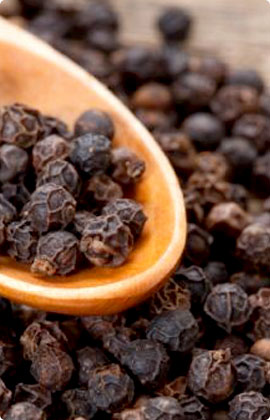
India Pepper and Spice Trade Association






Black pepper (Piper nigrum) is a flowering vine in the family Piperaceae, cultivated for its fruit, which is usually dried and used as a spice and seasoning. Black pepper is produced from the still-green unripe drupes of the pepper plant. The drupes are cooked briefly in hot water, both to clean them and prepare them for drying. The heat ruptures cell walls in the pepper, speeding the work of browning enzymes during drying. The drupes are dried in the sun or by machine for several days, during which pepper around the seed shrinks and darkens into a thin, wrinkled black layer. Once dried the spice is called black peppercorn. The berries are separated from the stem by hand and then sun dried without the boiling process.
Once the peppercorns are dried pepper spirit and oil can be separated from the berries by crushing them. Pepper spirit is mainly medicinal and beauty products. Pepper oil is also used as ayurvedic massage oil and used in certain beauty and herbal treatments.
Peppercorns (dried black pepper) are, by monetary value, the most widely traded spice can be volatile, and this figure fluctuates a great deal year to year, for example, pepper made up major portion of all spice imports. By weight , slightly more chili peppers are traded worldwide than peppercorns.
Pepper is native to South Asia and Southeast Asia and has been known to Indian cooking since at least 2 BCE. J Innes Miller notes that while pepper was grown in southern Thailand and in Malaysia, its most important source was India, particularly the Malabar Coast, in what is now the State of Kerala Peppercorns were a much –prized trade good, often referred to as “black gold” and used as a form of commodity money. The legacy of this trade remains in some Western legal systems which recognize the term “peppercorn rent” as a form of a token payment made for something that is in fact being given. The ancient history of black pepper is often interlinked with (and confused with) that of long pepper, the dried fruit of closely related Piper longum. The Romans knew of both and often referred to either as just “piper”. In fact, it was not until the discovery of the New World and of chili peppers that the popularity of long pepper entirely declined. Chili peppers, some of which when dried are similar in shape and taste to long pepper, were easier to grow in a variety of locations more convenient to Europe.
Before the 16th Century, pepper was being grown in Java, Sunda, Sumatra, Madagascar, Malaysia, and everywhere in Southeast Asia. These areas traded mainly with China, or used the pepper locally. Ports in the Malabar area also served as a stop-off point for much of the trade in other spices from farther east in the Indian Ocean . Following the British hegemony in India, virtually all of the Black pepper found in Europe, the Middle East, and North Africa was traded from Malabar region.
IPSTA believes in giving the power to the investor. We offer a variety of services on our Website and our newly launched Mobile App. A member investor can always come to our Website or Mobile App and check the latest trading resources we offer.
Online Trading Portal
Download Android App
Download iOS App